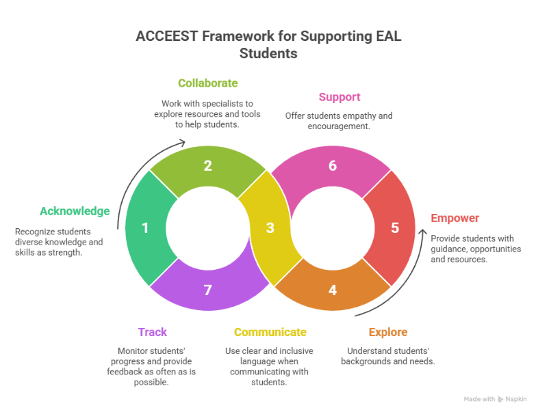EAL Students and Academic Integrity
EAL and international students are reported for academic misconduct more often — but research shows they don’t engage in it more than others. Misunderstandings and language barriers can lead to unfair assumptions.
By Susan Bens and Yolanda Palmer-ClarkeDid You Know?
Research shows English as an Additional Language (EAL) and international students are reported more often for academic misconduct (e.g., Beasley, 2016; Eaton, 2020) BUT there is no research that says they engage in academic misconduct more than their peers (Eaton & Burns, 2018).
EAL students are often misunderstood, which can lead to the perception that they are incapable of attaining high academic standards. As educators, it is essential that we understand EAL student needs and work together in supporting them to reach their goals.
Understanding Who EAL Students Are
Both local and international students may speak multiple languages. Owing to their orientation in languages other than English, many EAL students are challenged as they learn the processes of the university. Many must work harder to understand the differences between every day and academic language.
They may be:
- working harder to read and understand texts and assignments because they may have limited range of vocabulary;
- working harder to use consistent or correct grammar and incorporate a wider ranging vocabulary;
- feeling self-conscious about presenting their ideas in class, among peers, or directly to instructors;
- feeling anxious to ask questions about academic integrity out of a fear of being judged negatively by instructors and the legalistic terms used in policy documents about academic misconduct (Davis, 2022);
- transposing expectations and practices in other educational systems, in the case of EAL students whose prior education was outside of Canada (Harrad et al, 2024);
- fearing the use of GenAI detection tools that falsely identify human written work of EAL speakers with AI content (Sadisivan et al, 2025).
Many EAL students achieve academic successes whether they face these kinds of challenges or not.
Misconceptions of EAL students and Academic Misconduct
Just because an EAL student may have issues with spoken, in-the-moment English, does not necessarily mean this will also be true in their written work when they have time and access to permitted assistance. Instances of academic misconduct may be amplified as EAL students seek to understand the specific academic integrity expectations, especially when new and unfamiliar words are introduced. These students also often experience pressure or stress as they perceive themselves to be working harder than their peers who have English as a first language.
Supporting EAL Students to Success
- Structure assessment-related questions or instructions for an assessment in a clear and step-by-step manner so students are clear on what you are asking them to do. (e.g., making connections back to a rubric)
- Recognize the role GenAI technologies can play in helping students learn to communicate in English and give specific “do this, but not this” expectations related to GenAI use on written assessments so that students understand what an over-reliance/academic misconduct on the assessment in question would be.
- Scaffold student learning empathetically and using the process described in the ACCEEST framework.
- Refer students to University Library services – EAL support is free for all USask students who have an EAL background.
 Framework image created by Yolanda Palmer-Clarke, Learning Specialist - EAL, University of Saskatchewan
Framework image created by Yolanda Palmer-Clarke, Learning Specialist - EAL, University of Saskatchewan
----
References
This article was written in collaboration by:
Dr. Susan Bens, Academic Integrity Strategist, Teaching Innovation and Strategic Initiatives, and
Dr.Yolanda Palmer-Clarke,Learning Specialist, English as an Additional Language, University Library
Title image credit: Image adapted from Tridindia | Pixabay.com

